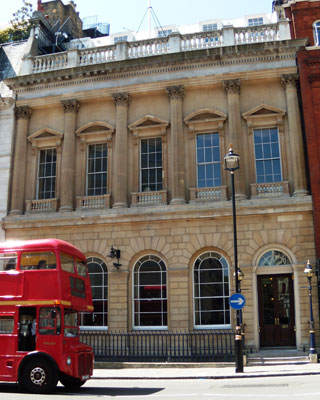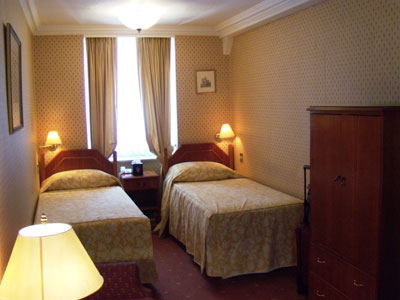Enter the secret world of London’s private clubs
by Lew Toulmin; Contributing Editor
What do these disparate famous people — real and fictional — have in common: James Bond, Phileas Fogg, Winston Churchill, Margaret Thatcher, the Duke of Wellington, Sir Arthur Conan Doyle, Rudyard Kipling and Gwyneth Paltrow? They all are or were members of private London clubs, many of which are just as fascinating, historic and beautiful as the standard London landmarks.
It used to be impossible for us “colonials” to enter, much less stay at, these rarified and highly secretive clubs, but that is changing. Let me give you a brief tour, describing a few of the clubs I have stayed at plus some of their quirks and how you can literally “join the club.”
The Carlton Club
The Carlton Club (69 St. James St.) is a temple to the Conservative Party. It is located in a deceptively standard-looking Georgian building, but, inside, a gorgeous interior space features a dramatic curving staircase topped by an amazing, large dome that is invisible from the street. The highlight of the club’s art collection is a portrait of the Queen Mother, with her signature on the nearby register.
The Carlton is just a few hundred yards from St. James’s Palace and close to the delightful shops of Jermyn Street. It was founded in 1832, and distinguished club members have included Winston Churchill, Benjamin Disraeli and Margaret Thatcher. Oddly, Mrs. Thatcher had to be made an “honorary man” in order to enter the club’s men-only bar.
In September 2010 my wife and I stayed at the Carlton Club in a long, narrow bedroom that had not been refurbished for many years. Our room, with twin beds, air- conditioning and en suite facilities, cost £145 pounds ($237), including VAT and full breakfast. (This was the discounted weekend rate; during the week, the cost was £195.)
The Reform Club
The Reform Club (104 Pall Mall) is the opposite of the Carlton Club — a beautiful paean to political and social reform. Built in 1841, it was inspired by Michelangelo’s Palazzo Farnese. Originally, members had to support the Great Reform Act of 1832, hence the name.
Famous members have included Winston Churchill (yes, he switched back and forth), H.G. Wells and Prime Minister William Gladstone, whose well-known (and very small) “Gladstone bag” was on display when we stayed at the club in September 2010. And it was there that Phileas Fogg, a fictional member, made a wager that he could depart the club and go “Around the World in 80 Days.”
The magnificent public rooms include a library with more than 75,000 volumes; a 120-foot-long dining room; a card room; a billiard room, and a “silence only” study and writing room.
Our bedroom was quite large, about 16 feet by 16 feet, with facilities en suite. Though attractive and refurbished, it had no air-conditioning. Including VAT and a full breakfast, the rate was £195 ($318) during the week, with a 15% reduction on weekends.
A few more mentions
Other clubs we have stayed at or visited include the Caledonian Club in Belgravia, with good, refurbished rooms at a reasonable rate; the Lansdowne Club in Mayfair, with slick, modern bedrooms and a historic public room where Benjamin Franklin negotiated the treaty which ended the Revolution and gave the US independence; the Royal Automobile Club on Pall Mall, perhaps the most magnificent club in London, and the Travellers Club, also on Pall Mall, its members including Talleyrand, Prince Phillip, the Prince of Wales and five British prime ministers.
There are about 60 active clubs in London (see Wikipedia’s “list of London’s gentlemen’s clubs”), so I have barely scratched the surface.
Some of the most amusing clubs are fictional. The Blades Club is the exclusive gambling and gourmet club frequented by James Bond, his boss, M, and his nemesis Goldfinger. It is modeled on the real Boodle’s, where Ian Fleming was a member.
One of the most famous fictional clubs is the Drones Club of Bertie Wooster and his man, Jeeves. This whimsical club created by P.G. Wodehouse was based loosely on the Bachelors’ Club and Buck’s Club and features members with delightful names like Barmy Fotheringay-Phipps and Catsmeat Potter-Pirbright.
Clubs, in general
Clubs are almost by definition a bit quirky. Dress codes usually include jacket and tie for men and, at least, pantsuits for women. Another oddity is that the bedrooms are often small and unrefurbished. This is because the clubs started out as gentlemen’s retreats where single men could collapse upstairs after a hard night of gambling and carousing. Always make careful enquires about the accommodations before booking.
Food quality can vary. It’s usually excellent for breakfast but often less good at lunch and dinner. The best bargain I found was at the Travellers Club, with dinner entrées at only £9-£10 ($15-$16) between 6 and 7 p.m.
Many clubs have admitted women as members in recent years, but some have no female members and a few of them bar women entirely. Quirky or plain silly? You decide!
The final quirk is that you need to have a club fax a “letter of introduction” to the London club in which you are interested in order to visit. To do this, you must be a member of a city, golf, university, alumni, faculty, country, yacht, military or other club that is part of a “reciprocal network” of clubs.
If you are not in such a network, you can join a local club that is. (See Wikipedia’s “list of American gentlemen’s clubs,” with more than 235 listings. Most of these admit women, and many have reciprocal networks with clubs not only in London but around the world.)
Join the club
If you would like to join, rather than just visit, your very own London club, consider the Royal Over-Seas League (ROSL), a nonprofit organization with extensive involvement in the arts and charitable and welfare activities.
The League, whose patron is Queen Elizabeth II, has 18,000 members. It’s large clubhouse has 80 modern bedrooms that are available to members at rates lower than a comparable hotel in downtown London. For example, a double room with en suite facilities costs £165-£185, including VAT and Continental breakfast.
Benefits include access to the ROSL clubhouses in London and Edinburgh as well as to numerous events, including church services at Westminster Abbey attended by the Queen, tea in the House of Lords and a chance at tickets to the Chelsea Flower Show and Wimbledon.
Membership for non-UK residents is a modest £112 per year, with a one-time 59-pound joining fee. The ROSL (St. James’s St., London; fax +44 [0] 20 7499 6738) has 80 reciprocal clubs around the world, including nine in the US.
If you prefer, you may be able to join one of the more exclusive London clubs. Usually, these have rates for overseas members much lower than for London residents. The Lansdowne Club will likely welcome foreign inquiries, and it has a list of more than 250 reciprocal clubs. Its overseas rate for a retired couple is £465 for the entrance fee plus £235 for annual membership.
Enjoy the secret club life, and perhaps you, too, will become famous in fact and fiction! ITN
Lew Toulmin is a member of the Cosmos Club in Washington, DC, which has a reciprocal network of over 100 clubs around the world.



